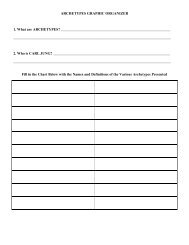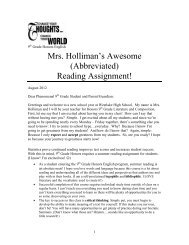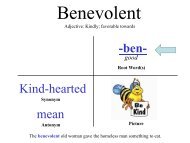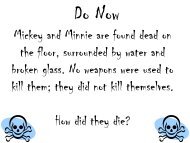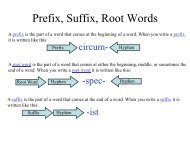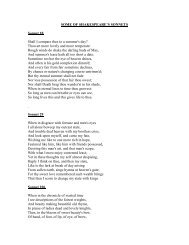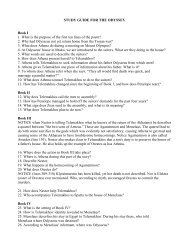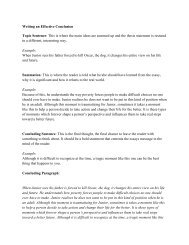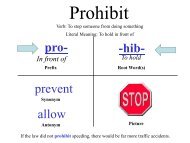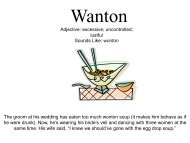Character Analysis Outline
Character Analysis Outline
Character Analysis Outline
Create successful ePaper yourself
Turn your PDF publications into a flip-book with our unique Google optimized e-Paper software.
Name<br />
<strong>Character</strong> <strong>Analysis</strong> Prewrite<br />
I. Introduction<br />
a. Hook your reader into your paper. Choose an introductory technique.<br />
b. BRIEFLY introduce the character you’ve chosen.<br />
c. Thesis: one sentence that explains which character traits you will discuss<br />
II. Body Paragraph #1 Trait__________________________________<br />
a. CLAIM/Topic Sentence: What are you trying to prove What aspect of your character<br />
are you discussing<br />
b. EVIDENCE/Concrete Detail - Direct or Indirect Quote with page number and/or<br />
description from the text. Support your claim.<br />
c. COMMENTARY #1-How does your evidence/quote clearly prove your claim<br />
d. COMMENTARY #2-How does your evidence/quote clearly prove your claim<br />
f. CONCLUDING SENTENCE-Restate, don’t repeat your claim/topic sentence<br />
III. Body Paragraph #2 Trait__________________________________<br />
a. CLAIM/Topic Sentence: What are you trying to prove What aspect of your character<br />
are you discussing<br />
b. EVIDENCE/Concrete Detail - Direct or Indirect Quote with page number and/or<br />
description from the text. Support your claim.<br />
c. COMMENTARY #1-How does your evidence/quote clearly prove your claim<br />
d. COMMENTARY #2-How does your evidence/quote clearly prove your claim
f. CONCLUDING SENTENCE-Restate, don’t repeat your claim/topic sentence<br />
IV. Conclusion<br />
What your conclusion should do:<br />
a. Answer the question "So What" Show your readers why this paper was important. Show<br />
them that your paper was meaningful and useful.<br />
b. Synthesize, don't summarize Don't simply repeat things that were in your paper. They<br />
have read it. Show them how the points you made and the support and examples you used<br />
were not random, but fit together.<br />
c. Redirect your readers Give your reader something to think about, perhaps you can show<br />
how your paper would be significant in the “real world.”<br />
Strategies for conclusions:<br />
d. Echoing the introduction: Echoing your introduction can be a good strategy if it is meant<br />
to bring the reader full-circle. If you begin by describing a scenario, you can end with the<br />
same scenario as proof that your essay was helpful in creating a new understanding.<br />
REMEMBER: Saying, “I feel,” “In my opinion,” etc. is redundant. YOU are the one writing the<br />
paper so I know you are writing your thought and your feelings. No need to say it.<br />
Concrete Details are FACTS and must come directly from the book as direct quotes or as indirect<br />
quotes.<br />
Commentary is OPINION. Be sure to explain what the quote/detail demonstrates or shows.<br />
You MUST have two Commentary for every one Concrete Detail.




